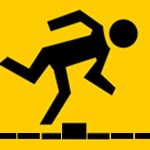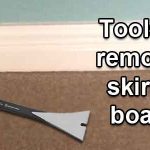Loose floorboards are very common. They can often be felt moving when you walk on them. Even more annoyingly, they will often creak. This can be quite annoying, but the truth is it is actually very easy to fix.
Providing your floorboards are not damaged, or don’t fit properly, they shouldn’t take more than a couple of minutes to fix.
The first thing you need to do is access the floorboards. Assuming you have a carpet installed, this will need pulling back to expose the lose floorboard. For other flooring the technique will be slightly different.

Carpet is relatively easy to pull back and replace. Simply start at the wall and pull the carpet away from the grippers. Do this until you are able to roll back the carpet and underlay, to expose your loose floorboard.
Next you can follow the steps below to repair your loose floorboard:
1 – Check for obvious damage
This is important, if the floorboard is cracked or damaged, then you may need to replace it. Floorboards could be damaged for many reasons, including:
- Wear and tear – This is just damage over time, often in old properties, the floorboards have been there untouched for decades, even centuries.
- Damaged by tradesmen accessing services below – This is very common, and some trades will just bodge the job to get finished, and then move on to the next job (you know who you are).
- Poor fitting – The floorboards could just be fitted badly. Maybe there are boards that are barely sitting on joists. Wrong fixings could have been used, or perhaps the boards were damaged during installation
- Rotten floorboards – Let’s face it, Britain is a damp country, and this damp often finds its way into our homes. Left untreated, the most common outcome is some kind of rot
2 – Remove the loose floorboard
Assuming the board is not damaged, and can be reused, you will need to remove it and check below before re-fitting.
If the board is already loose, this should be quite easy. If it needs a little help to lift up, a flat crowbar and a hammer can be used.
To do this, get your crowbar down the gap between the floorboards and pry it up, you should also use your hammer as a secondary lever. This can be placed further down as the board begins to lift. By doing this you will avoid too much leverage from the end, which could cause the board to snap.
3 – Check for joists, pipes, and wires
After removal we are looking for a couple of things.
- Firstly, we want to make sure the floorboard is supported at each end. This will mean each end is sitting on a joist.
- Secondly, we are looking for pipes and wires. The last thing you want to do is burst a pipe, or drill straight into a live electrical wire.
If the floorboard is not sat on a joist, this will need rectifying. Often, this will be a board that is just a little short, or barely sitting on the joist.
This could be due to the floorboards being installed badly. Also, it could have been done at a later date, by tradesmen accessing pipes and wires below, and re-fitted poorly. If this is the case, you will need to add a little extra support.
This may mean adding a piece of timber to the edge of an existing joist, where the board has been cut short. Here you just need to add an extra timber to carry the floorboard.
Once you are happy that the lose floorboard is supported, you just need to check for pipes and wires. Obviously, we want to avoid screwing into these, so you can mark their location on the floor above.
4 – Screw down your floorboard
Once the floorboard is well supported, and you are aware of any services running below, you can safely screw the floorboard back down. To do this, drill, and counter sink pilot holes where you intend to screw. This will avoid splitting the ends of your floorboards.
Next, with some wood screws, secure the floorboard in place by screwing through the pre-drilled holes.
In general, floorboards are between 18-25mm thick, so a 40-50mm wood screw will do the job perfectly.
Following this, your floorboard should be completely solid. Plus, you didn’t flood your house or electrocute yourself in the process.
Once you are happy with the job, you can pull the flooring back over, and carry on with your day.
Conclusion
Loose floorboards are pretty common, and thankfully repairing them is a very easy job. Anyone with a small amount of DIY knowledge can do this.
The most important point here, is to do the job properly. Make sure your floorboard is completely secure, and ensure you check for services (pipes & wires) below.
Do not blindly screw through floorboards without checking below first. You might get away with it once or twice, but hitting plumbing and electrics is a real risk. They are often notched into joists and just below the surface of the floorboards.
Trust me, if you hit a water pipe with a wood screw it will burst. If this happens, you better know where your stop tap is, or you are in big trouble. At this point a loose floorboard will be the least of your worries.
So don’t cut corners, take a few extra minutes to remove the board and check below.




